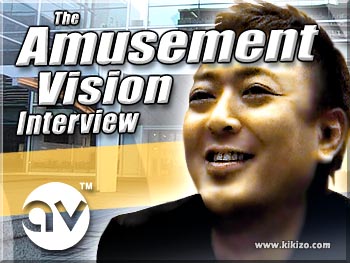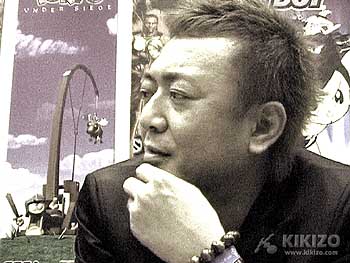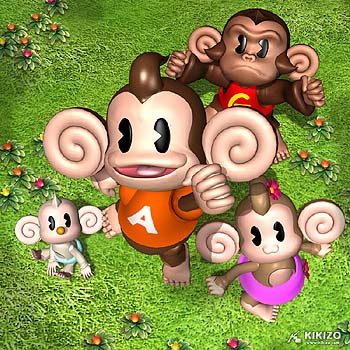Toshihiro Nagoshi: The Kikizo Interview
The third part of our in-depth Sega focus with charismatic Nagoshi-san looks at the brand new Spikeout for Xbox and... shhh... monkeys.
As recognised as Toshihiro Nagoshi is among the hardcore games community these days, he's still one of Sega's greatest unsung heroes. Many believe he's just the guy who created Super Monkey Ball and Virtua Striker, along with a few other key franchises of the Amusement Vision section at Sega. In fact he's one of Sega's oldest veterans who pioneered the 3D era with Yu-san by creating the bases for arcade Virtua Racing and Daytona USA, two titles that sparked the age of 3D polygon graphics, long before his Amusement Vision studio ever started.

Along with Naka-san and Suzuki-san, Nagoshi also oversees all creative development across the company, hence his title of General Manager, Creative Center - and as Sega's studios all begin to share the same lavatories again for the first time in many years, his role will be more important than ever. He is still directing game projects such as Spikeout Battle Street for Xbox, the focus of today's interview, but much of the hands-on development is taken care of by younger staff at the studio.
Nagoshi is a company man, keeping a keen eye on current and emerging technologies - Xbox Live being a particular curiosity for the new-look game legend. Nagoshi seems indifferent to recent changes at Sega's development organisation; the slicing of all those excess locks he previously sported - along with the new typically Japanese style and color - almost mirrors Sega's own shedding of baggage, leaner set-up and, we all hope, brighter future.
Anyway, enough with the rambling, it's time to find out more about Spikeout for Xbox - a game that will offer considerably more than you might have thought, as Nago-san reveals here. And yes, some cheap-shot banana slinging as well.
Stay tuned for the final part of our Sega interview special with Sega Wow boss, Kazunori Tsukamoto. Click here if you missed part one with AM2's top development brass, Makoto Osaki. Click here if you missed part two with Yuji Naka of Sega's Sonic Team.
![]()
Kikizo: People have been asking about a conversion of Spikeout for a long time. What made you finally decide to bring it to Xbox?
Nagoshi: Well we chose Xbox because it was the perfect choice in terms of the functionality in of the hardware for the contents of the game, which includes both real-time and multi fighter battles.
Kikizo: There have been several versions of the game in the past including Spikeout, Slashout, and Spikeout Final Edition. Is this version based on any particular one of those or a new game based loosely on the original?
Nagoshi: This is something totally new. We have a new scenario here where the background has seen ten years pass in terms of the characters and story since the Final Edition.
Kikizo: I am pretty certain that the was going to be a version of Spikeout released on Dreamcast, but obviously it never saw the light of day outside Sega's office, why was that the case?
Nagoshi: Well we didn't make any announcement that we were going to use Dreamcast and I explained at one point that this was because the hardware just didn't offer enough capability in terms of performance with Dreamcast.
Kikizo: Looking at the new visual style and artwork for the game, it seems like you're targeting the western market specifically compared to the arcade versions.
Nagoshi: Well in terms of the Xbox Live service, the service has greater penetration in the American market than in the European market, but the installed base overseas is of course greater in Japan. That's why we developed artwork more for the western audience. In terms of the software available for Xbox Live today there is of course some range but you will find so many shooting titles, I thought it would be nice for the western users for to have a game that offers multiplayer battles, so I felt it made sense to release the game now and target it in this way.
Kikizo: So what's new in the Xbox conversion and what has stayed pretty much the same since the various arcade versions?
Nagoshi: Well because this is for Xbox Live, we have incorporated voice chat. There is also a mode that lets you customise your game characters. Also you can download different content such as new items, and even new chapters and scenarios, through downloading.
Kikizo: How does the customisation and items system work, is it similar to Virtua Fighter 4 for PlayStation 2 or are there any big differences?
Nagoshi: It's similar to Virtua Fighter 4 in essence but in VF4 you have to reach certain points to obtain items, but in Spikeout you will have options to customise from the beginning.
Kikizo: This is the first time you have personally worked on the Xbox, how have you found it working with Microsoft - how has it been different to previous development experience?
Nagoshi: Well I don't know how to comment on that because we haven't seen the outcome of the result yet… but so far we have been getting a lot of support from them, just as Nintendo had given us.
Kikizo: You are obviously a very respected game producer, with several responsibilities at Sega, and also working on more than one title right now, so how much of your own time is spent on the product and how much of your own influence will show in the final product?
Nagoshi: Well, there are some directors and producers working with me, but I am the one who created the original basis of the game - now I work with much younger people! They are much closer to the users in age, and they are now the directors. In a sense I participated in this project not just to make this game but also to educate these young directors and producers.
Kikizo: Is it possible we might see further versions of Spikeout for the home console based on the Naomi editions such as Spikers Battle?
Nagoshi: Yeah, it's certainly possible if Spikeout Battle Street proves to be a success. I am not ready to make any decisions yet because we need to wait and see how this turns out, but if it is successful then we will entertain different options.
Kikizo: You have a lot of experience with all sorts of high-end hardware such as Model 3 and Naomi, from a designer's point of view how does the Xbox hardware compare to what you've used in the past?
Nagoshi: Well it's based on PC technology so it's easy to program. The young and experienced programmers at Sega are saying that Xbox is the easiest to program for from their point of view. So I think it's really good hardware and there's a lot of potential for the future.
Kikizo: One of the most distinctive features of the arcade Spikeout was the networked multiplayer experience, how will the transition to Xbox Live work out?
Nagoshi: Despite the changes of hardware, it will be pretty much the same as the arcade version; four players will co-operate to have fun, there is not much change. This is a something that's multiplayer to be enjoyed with your friends, you need to cooperate with the other players and the focus is real-time battles that you can enjoy with quick response.
Kikizo: And what about the single player experience, does it equally reward players who don't have any friends?
Nagoshi: Don't worry; this has stories and scenarios where even a player can battle with different opponents, so it will still be fun!
Kikizo: How big is the single player game in size and duration, and how varied will things be as players progress?
Nagoshi: Sixty hours in order to complete all the possible scenarios!
Kikizo: Wow, that's a load of time, is this possibly a reason why it's taken a long time to make, as the game was first announced over two years ago...?
Nagoshi: That was part of the reason, yes. But we also needed to ensure we had team members on board who understood the tricky networking aspects throughout the project, and that's another reason why it took time.
Kikizo: Will you included a free-for-all mode where people can just beat-each other up instead of other opponents?
Nagoshi: Yes, we'll definitely give that consideration to that aspect too.
Kikizo: But there's not going to be a fully-fledged competition where you could fight specifically against your friends?
Nagoshi: Well, we're still in the stage where we're discussing that possibility right now.
Kikizo: Mr Nagoshi, are you interested in ever making another game with monkeys again?
Nagoshi: [Laughs] We are working on it!
Kikizo: So we can expect to see it soon?
Nagoshi: I can't comment on that!
![]()
Click here for our early Spikeout playtest. Stay tuned for the final part of our Sega interview special with Sega Wow boss, Kazunori Tsukamoto. Click here if you missed part one with AM2's top development brass, Makoto Osaki. Click here if you missed part two with Yuji Naka of Sega's Sonic Team.
Adam Doree
Director, Kikizo.com
| Video Coverage (Latest Videos & Video FAQ) | |||
| PLEASE DO NOT DIRECT LINK TO ANY MEDIA FILE ON KIKIZO | |||
| Description | Dur. | Size | Details |
|
Spikeout Battle Street E3 2004: Direct feed trailer (640x480, 1Mbps) |
0.34m | 4.32 MB | WMV |
|
Spikeout Battle Street E3 2004: Showfloor gameplay (640x480, 1Mbps) |
0.44m | 5.59 MB | WMV |



















 Satoru Iwata Video Interview - the late Nintendo president spoke with Kikizo in 2004 as 'Nintendo Revolution' loomed.
Satoru Iwata Video Interview - the late Nintendo president spoke with Kikizo in 2004 as 'Nintendo Revolution' loomed. Kaz Hirai Video Interview - the first of Kikizo's interviews with the man who went on to become global head of Sony.
Kaz Hirai Video Interview - the first of Kikizo's interviews with the man who went on to become global head of Sony. Ed Fries Video Interview - one of Xbox's founders discusses an epic journey from Excel to Xbox.
Ed Fries Video Interview - one of Xbox's founders discusses an epic journey from Excel to Xbox. Yu Suzuki, the Kikizo Interview - we spend time with one of gaming's most revered creators.
Yu Suzuki, the Kikizo Interview - we spend time with one of gaming's most revered creators. Tetris - The Making of an Icon: Alexey Pajitnov and Henk Rogers reveal the fascinating story behind Tetris
Tetris - The Making of an Icon: Alexey Pajitnov and Henk Rogers reveal the fascinating story behind Tetris Rare founders, Chris and Tim Stamper - their only interview? Genuinely 'rare' sit down with founders of the legendary studio.
Rare founders, Chris and Tim Stamper - their only interview? Genuinely 'rare' sit down with founders of the legendary studio. The History of First-Person Shooters - a retrospective, from Maze War to Modern Warfare
The History of First-Person Shooters - a retrospective, from Maze War to Modern Warfare